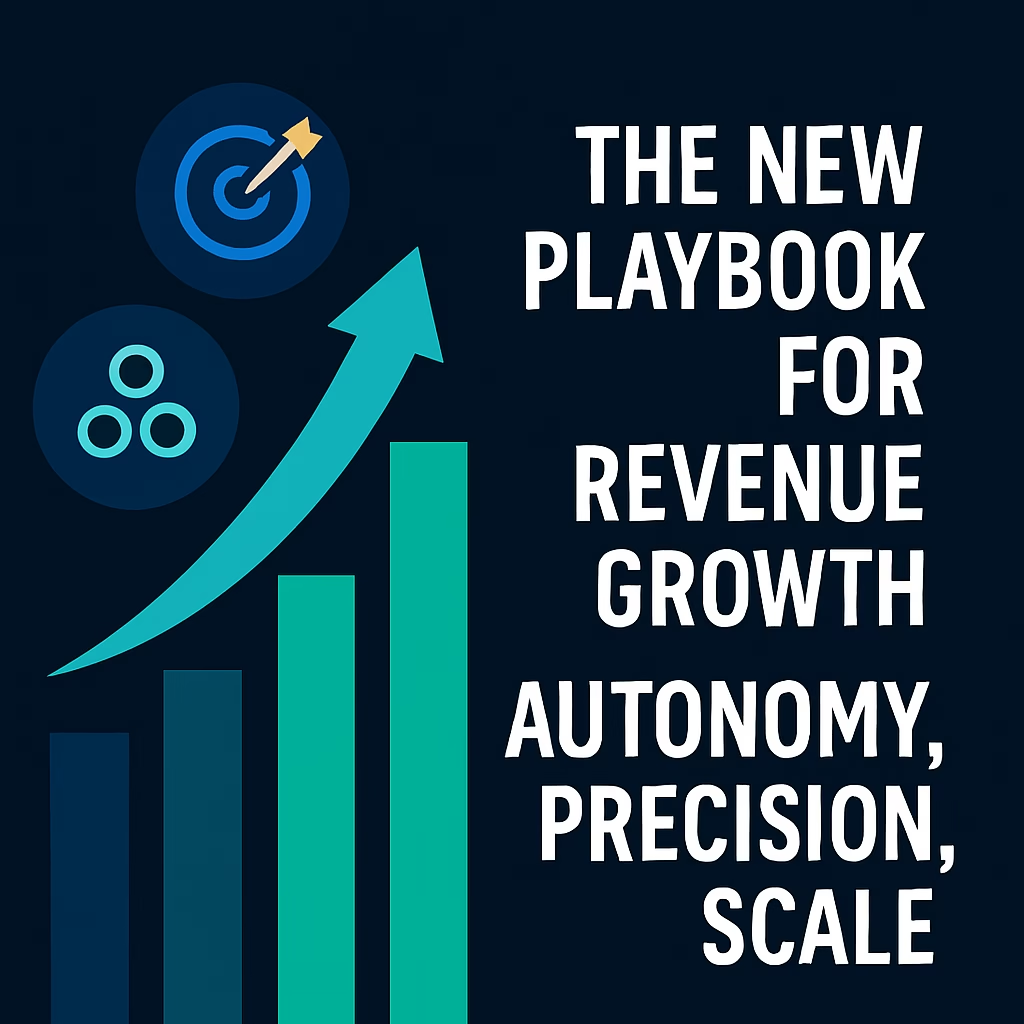The New Playbook for Revenue Growth: Scaling Revenue Teams with AI

For decades, revenue growth strategies have clung to a human-centric, manual playbook. Cold calls, manual pipeline reviews, spreadsheet forecasting, and relationship-driven selling once stood as the pillars of success. Today, they are relics of a system collapsing under its own weight.
The modern buyer is faster, more informed, and expects near-instant gratification. In contrast, the old playbook is slow, error-prone, and fundamentally reactive (McKinsey, 2023). A system designed for quarterly forecasts and human hunches cannot keep pace with a market that evolves daily. Worse, the talent churn and rising costs of traditional sales teams have made scaling manual operations a near-impossible task (Gartner, 2024).
Revenue growth today demands more than grit and grind. It demands a new playbook—one built not on effort alone, but on autonomy, precision, and scale.
Autonomy: Intelligent Systems That Act Without Waiting
Autonomy means moving beyond human bottlenecks. It is not about replacing humans, but about liberating them from repetitive, low-value tasks. In revenue operations, autonomy manifests through systems that not only analyze data but act on it—identifying risks, launching renewals, triggering upsells—without awaiting human intervention.
Autonomous systems reduce friction at every layer: they detect buying signals, personalize outreach, and even manage renewals without manual workflows. According to BCG (2024), companies that deploy autonomous revenue systems report a 30–50% acceleration in pipeline velocity and a 20% increase in forecast accuracy.
In this new paradigm, humans set the strategic intent; autonomous systems execute with relentless consistency. Revenue operations thus evolve from labor-intensive to intent-driven unlocking faster, more consistent revenue growth.

Precision: Moving from Approximation to Accuracy
The old playbook accepted imprecision as a given. Sales forecasts were notoriously wrong. Customer data was outdated. Personalization was based on broad personas rather than individual realities.
Precision in the new model means exactitude—acting based on real-time signals rather than intuition. It demands live customer telemetry, behavioral insights, and AI-driven scoring models that understand not just who might buy, but when and why. This shift is essential for predictable and scalable revenue growth.
Emerging leaders use micro-segmentation, hyper-targeted messaging, and predictive analytics to create demand with near-surgical accuracy (Forrester, 2024). Precision reduces waste, shortens sales cycles, and transforms conversion rates. It ensures that every dollar and every moment is spent where it matters most.
Scale: Systems That Grow Exponentially, Not Linearly
Historically, scaling revenue meant hiring more salespeople. Revenue growth was linear: double the team, double the pipeline. This approach is no longer viable.
Modern revenue organizations must scale exponentially. That requires systems designed for growth without proportionally increasing headcount. Automation, AI-driven decision-making, and platform-based architectures make it possible to expand coverage, touchpoints, and revenue capacity without a matching rise in complexity or cost (Accenture, 2024).
Organizations built for exponential scale leverage machine-driven playbooks that continuously adapt, self-correct, and learn. Growth is no longer limited by human capacity; it is powered by system intelligence.
How zeeproc Embodies Each Pillar
Autonomy:
zeeproc’s core engine operates autonomously across renewal management, upsell identification, and risk mitigation. It reads live CRM signals, adjusts plays in real time, and drives execution—without needing manual oversight.
Precision:
Every action inside zeeproc is guided by dynamic customer telemetry. Rather than operating from static lists or broad campaigns, it senses buying readiness, opportunity expansion, and churn risk based on real behavioral data, not outdated assumptions.
Scale:
Built as a lightweight, AI-native layer, zeeproc allows revenue teams to extend coverage across thousands of accounts with no proportional increase in operational burden. New territories, product lines, or market segments are absorbed seamlessly, enabling true exponential revenue growth.
Strategic Recommendations for 2025 Revenue Teams to Drive Sustainable Revenue Growth
-
- Redesign Roles Around Judgment, Not Execution
As systems assume more execution, human roles should concentrate on strategy, high-stakes negotiation, and relationship nurturing where human intuition matters most.
- Redesign Roles Around Judgment, Not Execution
-
- Invest in a Live Signal Architecture
Static CRM snapshots are obsolete. Revenue teams must invest in live, dynamic data architectures that feed real-time decisions and eliminate stale forecasting practices (Deloitte, 2024).
- Invest in a Live Signal Architecture
-
- Adopt a Playbook of Machine-Generated Actions
Rather than human-written sequences that age poorly, deploy playbooks that adapt automatically based on live telemetry, customer behavior, and feedback loops.
- Adopt a Playbook of Machine-Generated Actions
-
- Measure at the System Level, Not Just the Rep Level
Traditional KPIs like individual quota attainment must give way to system-wide efficiency, coverage, and velocity metrics. The system itself is now the first-class citizen.
- Measure at the System Level, Not Just the Rep Level
-
- Prioritize Autonomous, Modular Systems
Modularity enables rapid evolution. Revenue teams should avoid monolithic stacks and instead prioritize composable architectures where autonomous modules specialize in execution.
- Prioritize Autonomous, Modular Systems
-
- Train for Strategic Agility, Not Static Knowledge
2025 revenue leaders need the ability to pivot rapidly based on shifting data patterns. Ongoing strategic agility training will replace static sales certification programs (Bain & Company, 2024).
- Train for Strategic Agility, Not Static Knowledge
Final Thought: Play to Win, Not Just to Survive
The brutal truth is that revenue organizations clinging to the old model are not just falling behind—they are actively engineering their own obsolescence.
Winning in 2025 and beyond, and achieving meaningful revenue growth, demands more than survival instincts. It demands a mindset of dominance: building systems that are autonomous enough to act without hesitation, precise enough to leave no room for guesswork, and scalable enough to overwhelm markets without burning resources.
This is not a future ambition. It is the new standard. Play to win—or be left behind.

Hi Niranjan,
Really love the clear prescriptions for the future mentioned here. Invaluable gold nuggets.
Kumar